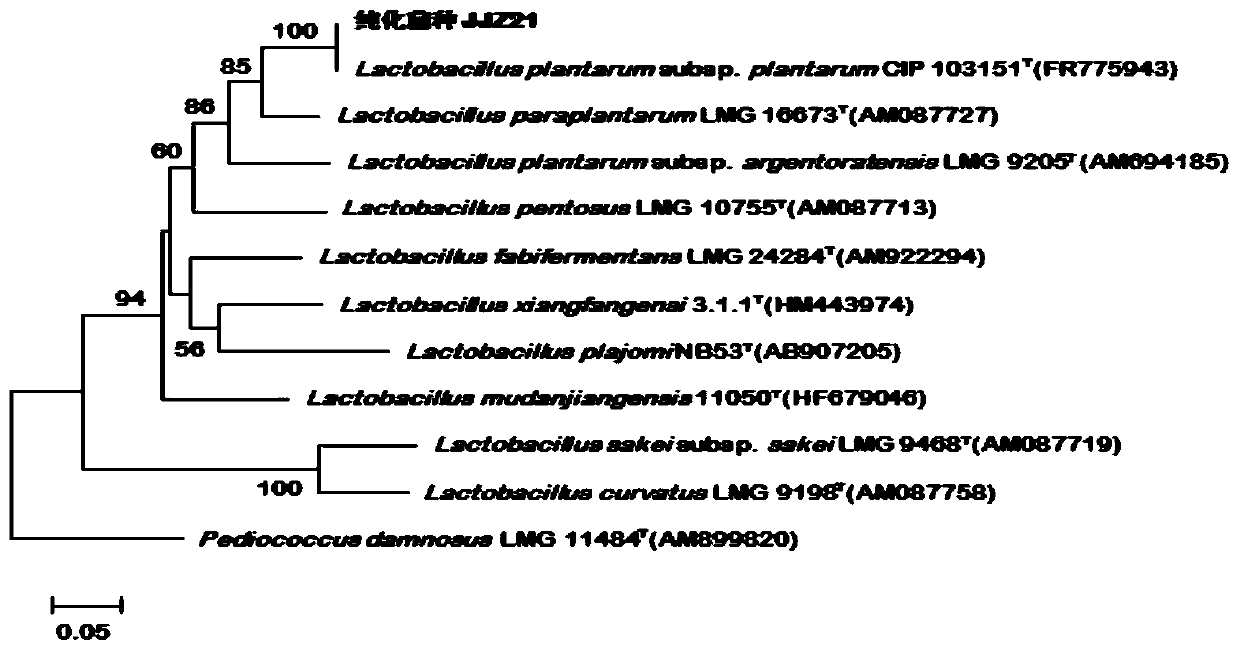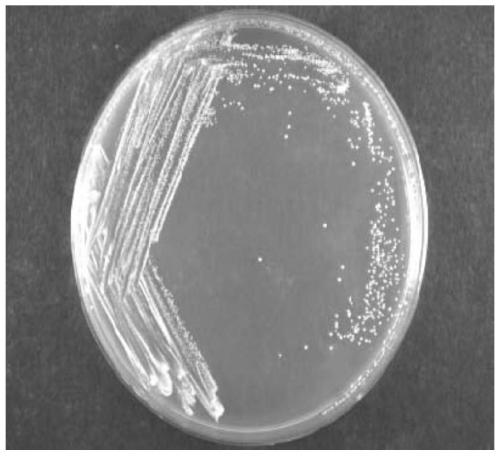A kind of lactobacillus plantarum strain and application thereof
A technology of Lactobacillus plantarum and vegetable oil, applied in the field of microorganisms, can solve problems such as difficulties in microorganisms, achieve the effects of high use value, improve oil production efficiency, and reduce oil production cost
- Summary
- Abstract
- Description
- Claims
- Application Information
AI Technical Summary
Problems solved by technology
Method used
Image
Examples
Embodiment 1
[0066] Embodiment 1: Screening and preservation of bacterial strains
[0067] Lactobacillus plantarum JJZ21 (or L.plantarum subsp.plantarum JJZ21) of the present invention is fermented from the self-made tea seed water slurry of Guizhou Teachers College "Key Laboratory of Development and Utilization of Guizhou Characteristic Biological Resources", No. 115, Gaoxin Road, Wudang District, Guiyang City, Guizhou Province The specific separation and identification steps are as follows:
[0068] 1. Obtaining the strain
[0069] Weigh 100g of tea seed kernels, add sufficient water and soak for 16 hours at 25°C, wash the soaked tea seeds, add water for 2 rounds of beating, and filter to obtain filtrate (that is, tea seed water slurry), and place the filtrate at 35°C Fermentation at constant temperature. After 5 hours, use the inoculation loop to dip the fermentation broth and spread it on the MRS plate for culture (25°C). Stain with methylene blue to observe whether it is a bacillus,...
Embodiment 2
[0083] Embodiment 2: Lactobacillus plantarum JJZ21 is applied to the production of vegetable oil
[0084] Weigh 1000g of Camellia oleifera seeds, add enough water to soak at 35°C for 16 hours, wash the soaked Camellia oleifera seeds, add water (tea seeds: water = 1:3) for 2 rounds of beating, and filter to obtain the filtrate. Ratio (tea seed yeast dry powder / filtrate: 1-5g / L) Add tea seed yeast (Meyerozyma caribbica JJZ11) to the filtrate, preserved in China Center for Typical Culture Collection (CCTCC), preservation number is CCTCC M 2016470; Chinese typical culture The preservation center and this laboratory can provide strains.) and Lactobacillus plantarum JJZ21 (the strains were activated in MRS liquid medium for 3 generations, and after adjusting the bacterial concentration to 3.0×109CFU / ml according to the McFarney turbidimetric method, press the fermentation broth 2% of the amount used for inoculation), stir evenly, put it in a container and place it in a constant temp...
Embodiment 4
[0090] Example 4: Lactobacillus plantarum JJZ21 is used to produce tea saponin.
[0091] Take tea seed saponin as an example. Weigh 1000g of tea seed kernels, add enough water to soak at 30°C for 16 hours, wash the soaked camellia seeds, add water (tea seeds: water = 1:3) for 2 rounds of beating, and filter to obtain the filtrate, which precipitates for 2.5 h, remove the precipitate, add tea seed yeast (Meyerozyma caribbica JJZ11) to the filtrate according to a certain ratio (tea seed yeast dry powder / filtrate: 1-5g / L), preserved in the China Center for Type Culture Collection (CCTCC), and the preservation number is CCTCCM 2016470; China Center for Type Culture Collection and our laboratory can provide strains), stir evenly, put it in a container and ferment at a constant temperature of 35°C for 5 hours, and then take out the floating matter on the upper layer. Then add plantarum lactobacillus JJZ21 in fermented liquid according to a certain ratio (bacterium classification is...
PUM
| Property | Measurement | Unit |
|---|---|---|
| smoke point | aaaaa | aaaaa |
Abstract
Description
Claims
Application Information
 Login to View More
Login to View More - R&D
- Intellectual Property
- Life Sciences
- Materials
- Tech Scout
- Unparalleled Data Quality
- Higher Quality Content
- 60% Fewer Hallucinations
Browse by: Latest US Patents, China's latest patents, Technical Efficacy Thesaurus, Application Domain, Technology Topic, Popular Technical Reports.
© 2025 PatSnap. All rights reserved.Legal|Privacy policy|Modern Slavery Act Transparency Statement|Sitemap|About US| Contact US: help@patsnap.com



